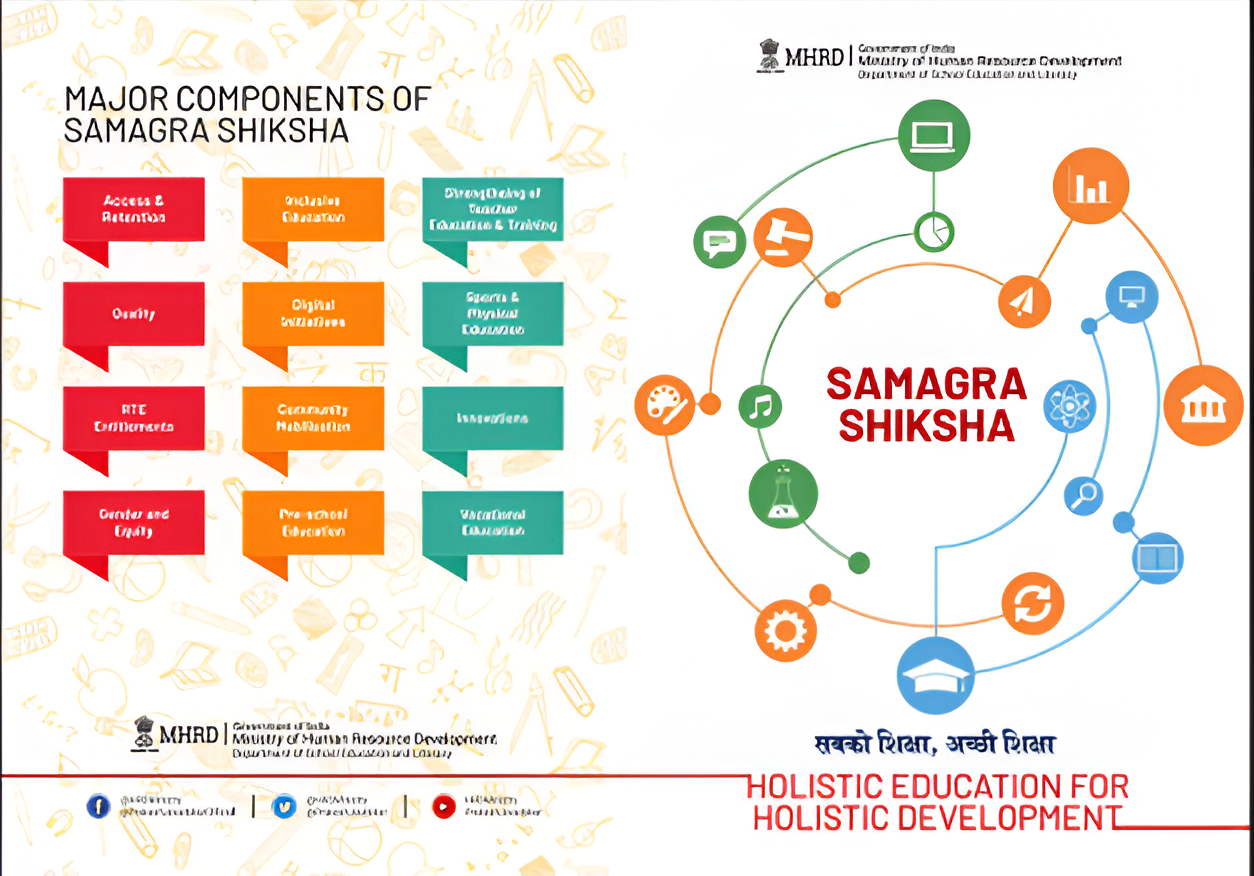Samagra Shiksha Scheme (2021–26)
 Click toview full image
Click toview full image
1. Introduction & Background
-
Launched: 2018, revamped for 2021–2026 with an outlay of ₹2.94 lakh crore.
-
Integrated Scheme combining:
-
Sarva Shiksha Abhiyan (SSA)
-
Rashtriya Madhyamik Shiksha Abhiyan (RMSA)
-
Teacher Education (TE)
-
-
Covers: Pre-school to Class XII
-
Aligned with:
-
Right to Education (RTE) Act, 2009
-
National Education Policy (NEP) 2020
-
Sustainable Development Goal 4 (SDG-4)
-
2. Vision
To provide quality, equitable, inclusive and holistic school education for all children, considering their diverse backgrounds, multilingual needs, and academic abilities.
3. Objectives
-
Implement NEP 2020 and RTE Act, 2009
-
Focus on Early Childhood Care and Education (ECCE) and Foundational Literacy and Numeracy (FLN)
-
Bridge social and gender gaps
-
Ensure equity, inclusion, safety, and quality learning outcomes
-
Upgrade SCERTs, DIETs, and teacher education structures
-
Promote vocationalisation, sports, digital learning
4. Coverage & Reach
-
11.6 lakh schools, 15.6 crore students, 57 lakh teachers
-
Government and Aided schools from pre-primary to Class XII
-
Stakeholders include teachers, SCERTs, DIETs, parents, SMCs, volunteers, BRCs, CRCs
5. Key Features
a) Holistic Approach
-
Continuum from pre-school to Class XII
-
Unified administrative and funding structure
b) Technology Integration
-
PRABANDH system on Shagun portal for monitoring fund release, approvals, UDISE+ data
-
Support for ICT labs, smart classrooms, DTH, and digital content
c) Pedagogical Focus (5+3+3+4 structure)
-
From Anganwadi to Senior Secondary
-
Activity-based, experiential, and multidisciplinary learning
d) Quality & Innovation
-
Support for Padhe Bharat Badhe Bharat, Rashtriya Avishkar Abhiyan
-
Introduction of Holistic Progress Cards (HPCs)
-
Strengthening PARAKH (National Assessment Centre)
e) Equity and Inclusion
-
Upgrading KGBVs to Class XII
-
Enhanced aid for CWSN, girls with disabilities
-
Self-defence training (Rani Laxmibai Atma Raksha Prashikshan) with increased funding
-
Focus on aspirational, LWE, border and educationally backward districts
f) Support for RTE Entitlements
-
Uniforms: ₹600/child/year
-
Textbooks: ₹250–400/child/year
-
Library grants: ₹5,000–₹20,000
-
Composite School Grant: ₹25,000–₹1,00,000
-
Transport up to ₹6,000/year (Class 1–12)
6. Focus Areas
| Component | Key Interventions |
|---|---|
| ECCE / Pre-Primary | ₹500/child for TLM, training for Anganwadi workers, support in govt. schools |
| Foundational Literacy | Support under NIPUN Bharat: FLN materials, ₹500/child TLM, district-level assessments |
| Secondary Education | Universal access till Class XII, transport, curriculum flexibility, support via NIOS for out-of-school children (16–19 years) |
| Vocational Education | Integration from Class 9–12, support for aided schools, exposure via internships, hub-and-spoke model |
| Sports & Physical Ed. | ₹5,000 (primary), ₹10,000 (upper primary), ₹25,000 (secondary) per school; extra grant for Khelo India national medal winners |
| Girls’ Education | Upgrade KGBVs, hostel support, menstrual hygiene provisions, DBT, hostels for girls (Type IV KGBV) |
| Teacher Training | Training via SCERTs/DIETs, NISHTHA, unified calendar, dynamic training needs assessment |
| Assessment & Monitoring | Set up assessment cells at SCERTs, conduct achievement surveys, social audits (20% schools/year), KPIs for each scheme component |
| Language Learning | Hiring Hindi/Urdu teachers, bilingual TLMs, specific training |
| Digital Education | Operation Digital Board, flipped classrooms, virtual platforms |
7. Governance & Implementation
-
States/UTs have flexibility to prioritise interventions.
-
Use of KPIs for outcome tracking.
-
Implementation aided by revised programmatic and financial norms issued in August 2021.
Samagra Shiksha: Digital & DBT Initiatives
1. Direct Benefit Transfer (DBT)
-
The redesigned scheme emphasizes direct outreach to students through child-centric interventions via DBT mode.
The redesigned scheme emphasizes direct outreach to students through child-centric interventions via DBT mode.
2. ICT and Digital Initiatives
-
Financial assistance is provided to States/UTs for:
-
ICT Labs
-
Smart Classrooms
-
Digital Boards
-
Virtual Classrooms
-
DTH Channels
Financial assistance is provided to States/UTs for:
-
ICT Labs
-
Smart Classrooms
-
Digital Boards
-
Virtual Classrooms
-
DTH Channels
3. Grant Structure:
States may choose one of the two ICT configurations:
Option 1: ICT Labs (for Classes 6–12)
-
Non-recurring grant: ₹6.40 lakh per school
-
Recurring grant: ₹2.40 lakh per school/year (for 5 years)
Option 2: Smart Classrooms (max 2/classrooms per school)
-
Non-recurring grant: ₹2.40 lakh per school
-
Recurring grant: ₹0.38 lakh per year
Recurring cost covers:
-
Instructor salary/support
-
E-content and digital resources
-
Electricity and internet charges
Q. With reference to the Samagra Shiksha Scheme, consider the following statements:
-
It subsumes Sarva Shiksha Abhiyan (SSA), Rashtriya Madhyamik Shiksha Abhiyan (RMSA), and Teacher Education (TE).
-
It covers the entire school education spectrum from Class I to Class XII.
-
It is aligned with the Sustainable Development Goal 4 (SDG-4) on quality education.
Which of the above statements are correct?
A. 1 and 2 only
B. 1 and 3 only
C. 2 and 3 only
D. 1, 2 and 3
Answer: D
Q. Consider the following statements about PRABANDH and UDISE+ under Samagra Shiksha:
-
PRABANDH is a platform for tracking fund releases, school gaps, and monthly progress reports.
-
UDISE+ is the only source used for physical infrastructure approvals.
-
Both PRABANDH and UDISE+ are integrated into the Shagun platform.
Which of the above are correct?
A. 1 and 2 only
B. 1 and 3 only
C. 2 and 3 only
D. 1, 2 and 3
Answer: B
Explanation: UDISE+ is a major source but not the only source for approvals.
Q. Which of the following are new interventions introduced in the revamped (2021–26) Samagra Shiksha?
-
Holistic Progress Cards (HPCs) for learner assessment
-
Child tracking provision and DBT mechanisms
-
Inclusion of bilingual teaching material and support for Hindi and Urdu teachers
-
Revised norms for Programmatic and Financial planning
Select the correct answer:
A. 1 and 2 only
B. 1, 3 and 4 only
C. 2, 3 and 4 only
D. 1, 2, 3 and 4
Answer: D
